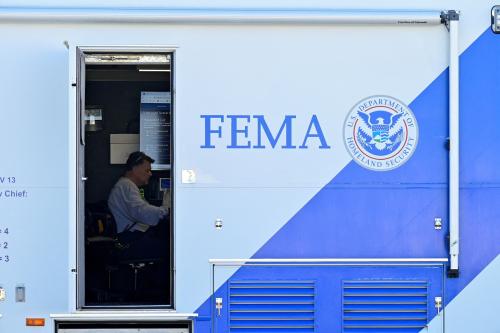Note: In April 2010, the Project published an updated version (IASC Framework on Durable Solutions for Internally Displaced Persons), which was endorsed by the IASC. The new version and any translations of it are available on our website at https://www.brookings.edu/reports/2010/0305_internal_displacement.aspx. The links to the Framework on this page refer only to the original, pilot version as it was published in 2007.
Read Framework »
Read full Framework » (with supporting documents)
En Français »
En Español »
It is usually easy to say when refugees stop being refugees – when they return to their home countries; when they become citizens in another country; or when their legal status is removed for other reasons. In contrast it is far more difficult to assess when internal displacement ends. There are at least 24 million internally displaced persons (IDPs) in the world today. They do not have a special legal status that ends at a particular time. And as citizens of the countries where they are displaced they have every right not to go home even once it is safe to do so. Yet it is important to be able to say when internal displacement has ended – so that governments and the international community can target limited resources, and also to remove the stigma of the label from the people involved. When, then, can it be said that internal displacement has ended and a durable solution for IDPs has been found?
To answer this question, The Brookings Institution – University of Bern Project on Internal Displacement and the Institute for the Study of International Migration at Georgetown University, at the request of the Representative of the U.N. Secretary-General on the Human Rights of Internally Displaced Persons, Walter Kälin, undertook an extensive inquiry. The result of this process was the creation of the Framework for Durable Solutions, which shows that the ending of displacement occurs not at one point in time but is a gradual process.
When Displacement Ends: A Framework for Durable Solutions helps to define the situations when it can be said that displacement has ended and those formerly displaced no longer require the specific attention given to them as IDPs. This solution is created through processes and marked by conditions on the ground.
The following are processes through which a durable solution can be found:
- IDPs are able to make an informed decision as to whether to return, remain where they are, or settle elsewhere in the country
- IDPs, including disadvantaged groups, participate fully in the planning and management of return, local integration or settlement elsewhere in the country
- To the extent possible, arrangements have been made for IDP representatives to visit and assess conditions for return or settlement elsewhere
- No coercion – including physical force, harassment, intimidation, denial of basic services, or closure of IDP camps or facilities without acceptable alternative – has been used to induce or to prevent return, local integration or settlement elsewhere
- National authorities, where appropriate with the support of the international community, have taken appropriate measures to establish conditions, as well as provide the means, to enable IDPs to return voluntarily, in safety and dignity, or to resettle voluntarily in another part of the country and to facilitate the (re)integration of returned or resettled IDPs
- National authorities grant and facilitate safe, unimpeded and timely access of humanitarian organizations and other relevant actors to assist IDPs to return, locally integrate or settle elsewhere in the country
The following are the conditions that mark a durable solution:
- Formerly displaced persons do not suffer attacks, harassment, intimidation, persecution or any other form of punitive action upon return to their home communities or settlement in other locations
- Formerly displaced persons are not subject to discrimination for reasons related to their displacement
- Formerly displaced persons have full and non-discriminatory access to national and sub-national protection mechanisms, including police and courts
- Formerly displaced persons have access to personal documentation, which typically is needed to access public services, to vote and for administrative purposes
- Formerly displaced persons have access to mechanisms for property restitution or compensation regardless of whether they return or settle in the area where they found refuge or a new location
- Formerly displaced persons enjoy without discrimination an adequate standard of living, including shelter, health care, food, water and other means of survival
- Formerly displaced persons have been able to reunite with family members if they choose to do so
- Formerly displaced persons are able to exercise the right to participate fully and equally in public affairs
As stated in the publication’s Foreword by the Representative, this Framework “is intended to assist governments in devising national legislation, policies and programs that promote solutions to internal displacement. It is also expected to provide guidance to international organizations to assist their work in different country contexts, in particular to promote a coherent transition from humanitarian aid to reconstruction and development…. The Framework also should enable civil society organizations to monitor the extent to which governments fulfill their responsibility to find durable solutions for IDPs and as a basis for their own work promoting the creation of conditions enabling these solutions.”
The Brookings Institution is committed to quality, independence, and impact.
We are supported by a diverse array of funders. In line with our values and policies, each Brookings publication represents the sole views of its author(s).


